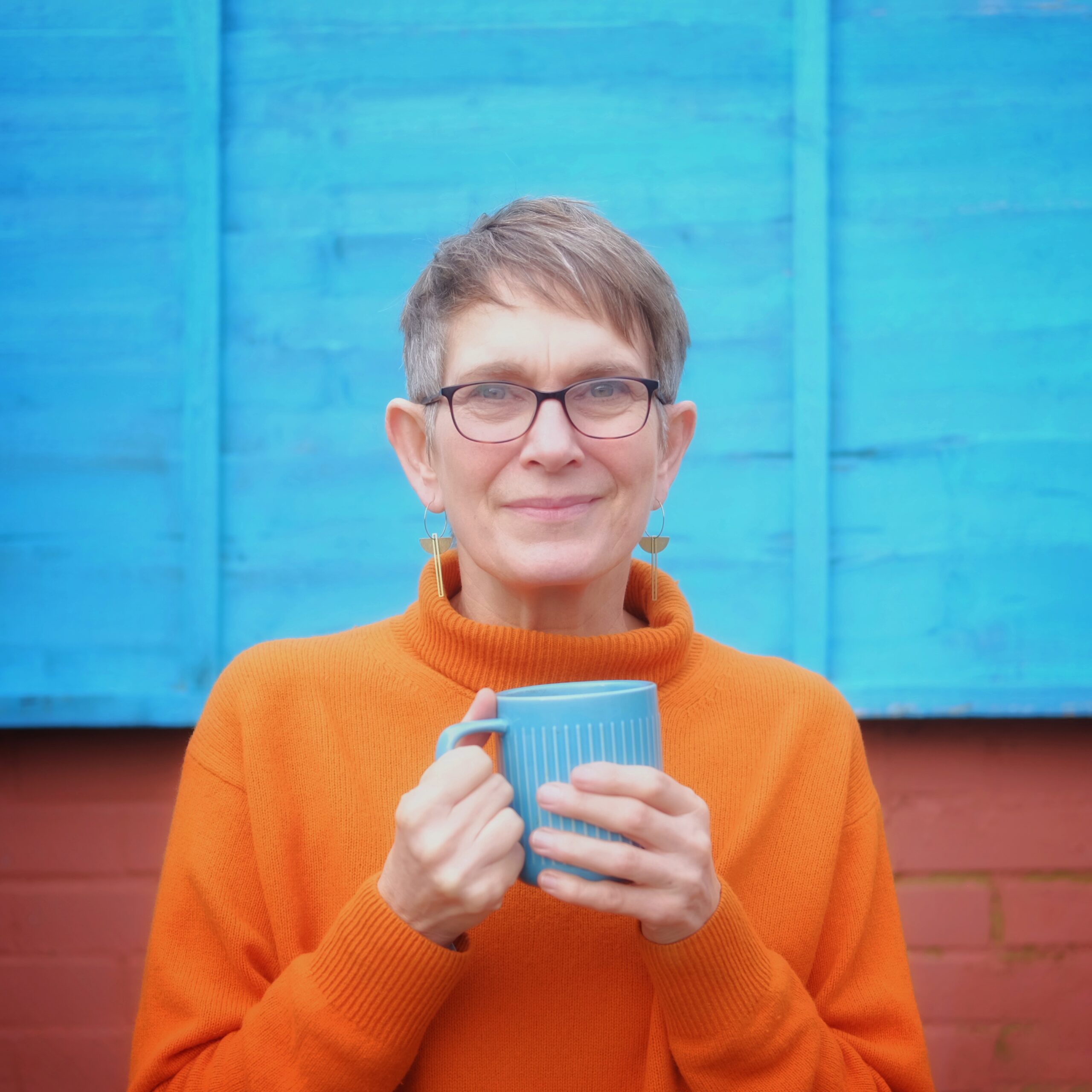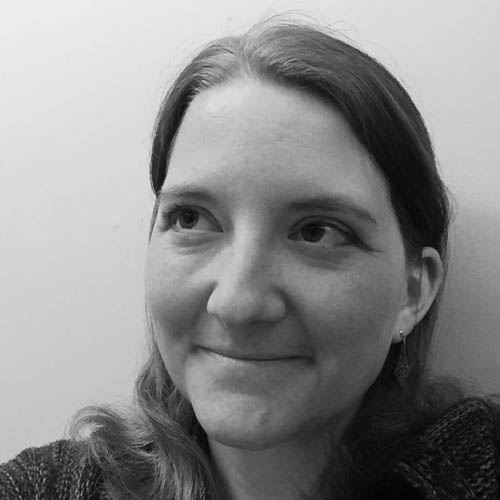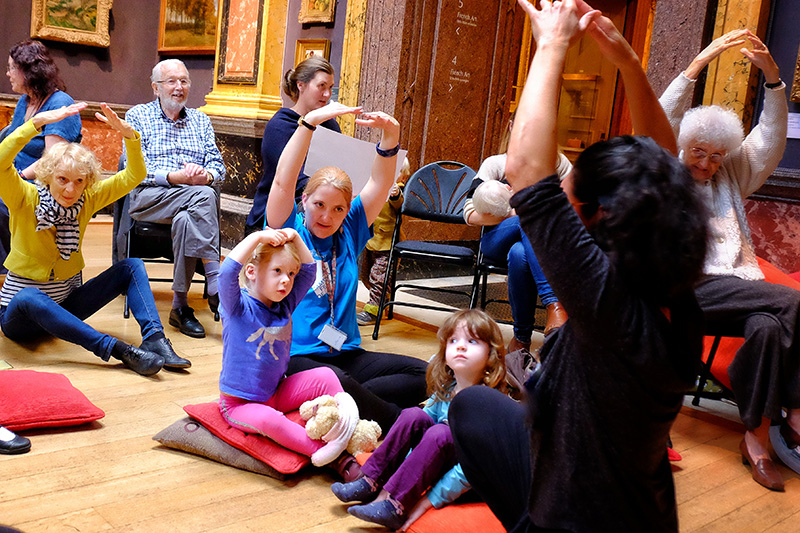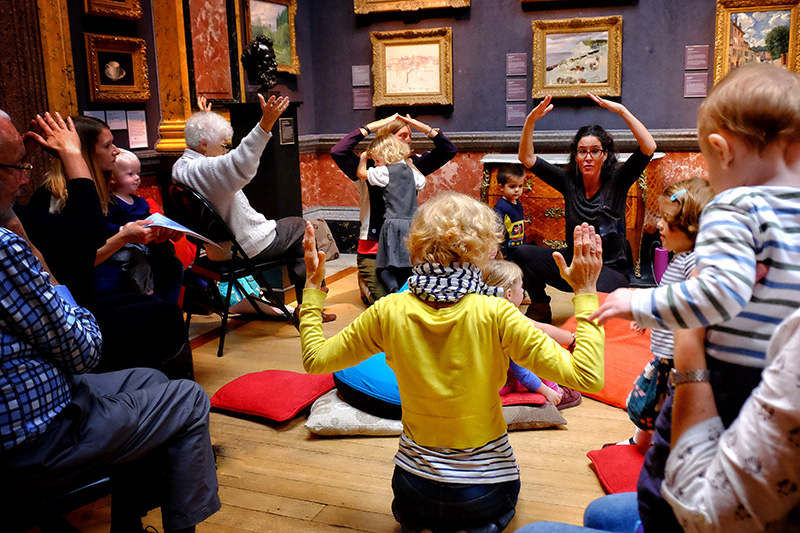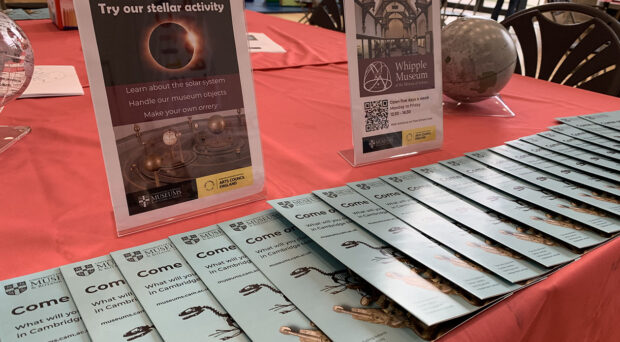What happens if we bring our bodies to the museum … along with our heads and hearts?
An experiment at the Fitzwilliam Museum, as part of the Cambridge Festival of Ideas 2018, looked at this disconnect by inviting older people, young children and their parents to come together and to do just this through an invitation to dance – with art. Ruth Clarke and Nicola Wallis from the Museum’s Learning Team and Filipa Pereira-Stubbs, dance artist, share this experiment.
Visiting a museum or gallery can be a static experience. Generally, unless lucky enough to be a small child, we are not invited to even consider visiting ‘with our bodies’, by which I mean, doing more than being in them in static poses or employing them to ‘walk by’. For many of us our experience is that our bodies are a bit unwelcome (by us), aching as we stand and gaze, tired as we plead with them to bear with us for just one more picture… sagging under the weight of our outdoor coat and bag (we really should have gone to the cloakroom) and creaking as we struggle to get up from those super-low benches.
So, what would it be like if we ‘visited with our bodies’, moving and dancing in the galleries as we feel, think and respond to the objects, art works, stories and atmosphere surrounding us – acknowledging the positivity of the physicality of our visit?
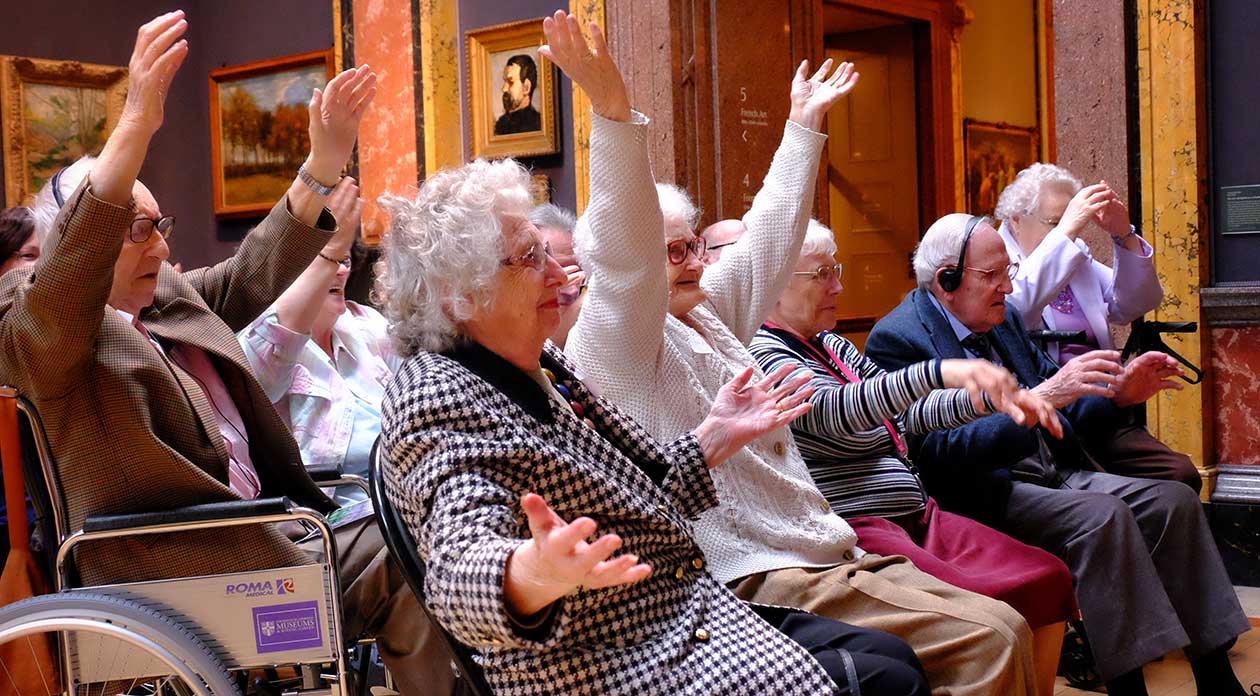
At the Fitzwilliam Museum, we have been playing with this idea and indeed how to create the conditions to move and dance for the past year and a half, joining with older Cambridge residents supported by the Independent Living Service under the creative guidance and gentle care of dance artist Filipa Pereira-Stubbs. The programme, Dancing at the Museum, has allowed us to enjoy a shared process of looking, responding to and moving to art. In doing this we have found that not only does our ability to really enjoy the collections increase, but also our sense of personal and group wellbeing and our ‘knowing’ that the museum is a place we are welcome… all of this done whilst mostly sitting on seats, keeping ourselves and the art safe!
Small children are very familiar with this idea. They know that their bodies and minds are one; there is no need to ‘create the conditions’ for that connection to take place. Knowing this and also knowing how much they visibly enjoy moving through, being in and indeed moving ‘on’ the museum led to the idea that maybe these two groups might enjoy moving and dancing together; the elders sharing the practice that they had developed with the museum and the children their intrinsic knowledge that moving and dancing is a legitimate response to… anything!
Our idea was…
…as part of the Festival of Ideas, to run a workshop/s where members of the Dancing at the Museum programme host children, along with a parent/carer, in an exploration of a painting or paintings: looking, building stories, naming feelings, choosing music and moving together. In doing this we hoped to find out if old and young have an enhanced experience by being together and, if so, what are the qualities of the experience and the difference made.
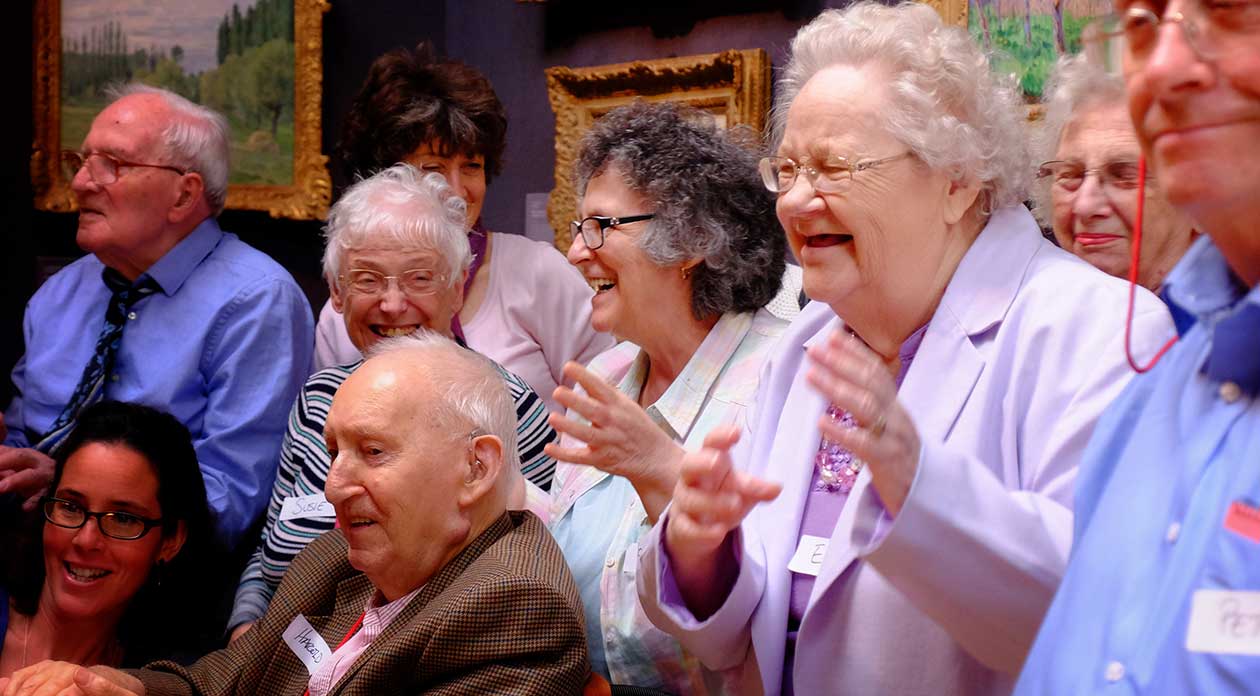
Realisation … the steps taken to make ‘the idea’ happen
- Discussion with the Dancing at the Museum participants: did they feel the idea had some merit and if so, what was this? How should it be approached, what could their role be and, critically, did anyone want to do it?
- Choosing the gallery and artworks to focus on; the dancers’ favourite gallery in the Museum is Gallery 5 containing artworks by Impressionist artists; this is where the programme began and its seasonal curatorial display lends itself to return visits. As such, the group know the gallery well and the art within it, in fact when discussing options, they referred to it as ‘our gallery’. Being in this space meant that the elders would be able to draw on their familiarity with the collection when acting as hosts.
- Devising a session structure: how could the practice developed to date translate to this new intergenerational setting? How to set the scene to support the participants’ emotional and physical arrival in the gallery, how could we all settle ready to begin? What timings, group sizes, and furniture would foster effective engagement and how could we segment the session content (looking, sharing, interpreting, moving and dancing together) so that everyone was included and all had the space, time and support needed to connect with each other, the art, the museum and the practice?
- Making the offer: constructing a description of the sessions for the Festival of Ideas brochure that would inspire parents/carers to see the potential of their child participating in the programme (target participants being children aged 3-5 years and a parent/carer).
Our agreed approach
- To take play seriously, placing no pressure or expectations on others; for it to be unspoken and agreed that play could be used to serious effect, an anchor for the Dancing at the Museum programme.
- Use the paintings and artwork as the stimuli for activity and the dance and movement as the means for communication.
- To close the gallery and make it a special place with cushions and seats, conducting our group on all levels; floor, chair and standing, making the spaces to move safe for participants and artefacts!
- To share leadership giving the young and old agency to direct the session based on their personal experiences.
- Create the conditions for and foster the sharing of different points of view.
- To take chances (managed of course!) with the permission of all involved.
What we did
- We ran two sessions on the same day, one in the morning and the other the afternoon, each for an hour and a half.
- At the start we prepared separately for thirty minutes. The elders, Filipa and Ruth were in the gallery exploring our perceptions of the opportunities and any challenges ahead, while the children and parents/carers were with Nicola taking part in scene-setting activities in the art studio to help seed and prepare for the newness of the experience.
- We began with the elders, parents and team members seated in a semi-circle in front of a case of Degas dancers. The children were invited to sit on cushions on the floor in what was a safe contained space. Using the Degas statues as stimuli, Filipa led us in a physical warm up where we looked at the gallery itself and the art on display to inspire movement.
- From here we looked at three/four artworks in the gallery, each with a very different emotional content, sharing together what we could see, the feelings evoked, and dancing in response to these. In the first session, we did this in four small groups moving from painting to painting, and in the second session we moved as one (large group).
- To finish we identified the painting we had enjoyed most and shared why, and then the one in the gallery that we would like to dance to next time. We ended with thanks and messages of gratitude to each other for our time together.
- To evaluate we asked the parents/carers and children to complete a simple questionnaire and the elders to take part in a plenary session. We committed to bringing the material for both of these together into this blog post to help us consider what had been achieved and what might happen next.
What emerged?
- The Museum team stepped aside as translators of knowledge and were able to hand this over to the group, who took the lead in supporting new stories and connections to be made.
- People invited each other into partnerships or trios, offering ideas and responses through gesture, body language and spoken word, confident early on, tacitly understanding the invitation that was being made to all.
- Parents/carers were as much involved as the children and elders, visibly enjoying themselves, relaxing into and becoming part of the experience their children were having.
- It was evident throughout the feedback that museum had become or was a favourite place: a place that is yours to enjoy, learn and express yourself in or just be in, a safe, inspiring, welcome refuge.
- Relationships and trust built quickly in a short time, with demonstrations of joy, reciprocity, kindness and imaginative interaction.
Considering what next, thoughts to frame the way ahead
Some parents chose to bring along infant siblings with their children. This altered how they interacted with the session; key to the ‘idea’ was communication between participants, building responses to the art together. What that communication can look like and then how to establish the conditions for this are questions going forward.
The elders are now an established group, who through getting to know each other and the museum have become ‘practitioners’ in the Dancing at the Museum programme. Could their role as hosts and the children and their parents/carers as collaborators be enhanced if the sessions took part on a regular basis allowing relationships to build?
Ratios of adults to children; with the parents, elders and project team all being adults… and the children being – the only children! An imbalance was created which lessened the opportunity for the work to focus upon the coming together of the elders and the children. However, the parents blossomed in the session, so being without them would be to miss a wonderful opportunity. Does the role of the museum team and in turn the elders need to be adjusted or do we need to look at alternative or additional models where the session is more populated by children and less by adults? If we do this, which adults would we be prepared to see fewer of?
Running the sessions in two ways, i.e. in four smaller groups and then as one large group, offered different opportunities. The large group, led by Filipa, with the elders modelling the practice and making the invitation to participate was lots of fun, quite high energy and packed with creativity. It was however looser at times than would be preferred (in a fragile gallery context) and lacked direct leadership from the elders. The small groups limited the number of exchanges that could be made, but allowed for the elders to work more closely with the children and make more extended connections. This worked really well overall, but where the elders felt less confident it increased pressure on them and at times lacked the creative energy that the whole group model enjoyed.
What next? We have a plan, not for sharing just yet! It is gaining traction and may just be able to make off the page, out of our heads and into the museums in 2019. Watch this space…

